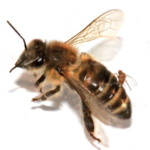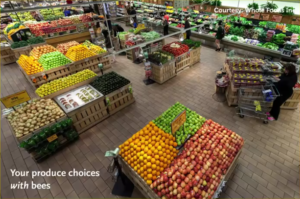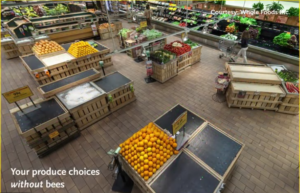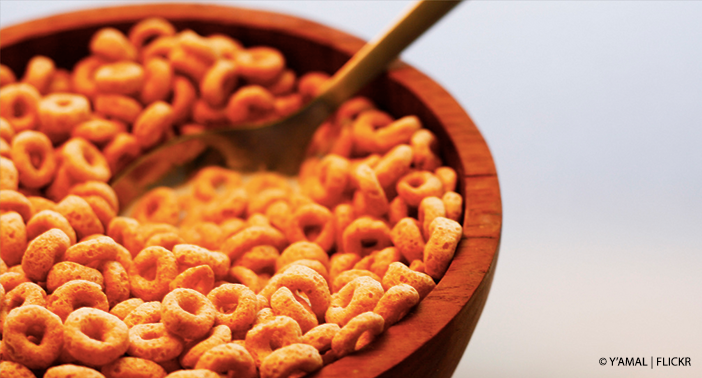What did you have for breakfast this morning? A cup of coffee? Avocado on toast? Berries and yogurt? Some honey nut cereal by chance? If you answered yes to any of these questions, you consumed a product pollinated by bees, the hard-working insect that allows you to stay hard at work. Bees are essential for our food sources at multiple levels. Not only do they directly pollinate certain foods such as fruits and vegetables, but they also pollinate flowers and other vegetation which is then consumed by the animals that some of us later eat (BBC).
Some WILD stats for you:
- 1 in 3 bites we take is made possible by pollinators
- 70 of the top 100 food crops are pollinated by bees
So what’s all the buzz about?
Unfortunately, bee populations are rapidly declining, so try to rethink your breakfast options without them…it’s pretty bleak. Since 1942, bee populations have been cut in half, while the production of crops that require bee pollination have grown by 300%, creating a huge gap.


Their decline can be attributed to 3 main interacting factors: disease, pesticides, and monocultures/flowerless landscape.
- Disease: The parasitic Varroa destructor mite is the enemy of bees, leading to weakened immune systems and widespread disease. This can often lead to Colony Collapse Disorder (CCD) which is increasingly becoming a problem in bee populations where the worker bees abandon their queen and the immature bees due to infection.
- Pesticides: As agriculture becomes more and more industrialized, with farmers always looking for options to increase yield and cut their losses from harmful pests, bee-killing pesticides are being used in mass amounts. Neonicotinoids are a type of pesticide used on flowering plants that are attractive to bees and can be partially blamed for the bee decline, so places such as Europe have actually temporarily banned their usage. Neonicotinoids are toxins that cause the bees to twitch and die or be disoriented enough that they cannot find their way back to the hive. Herbicides are commonly used by farmers to kill off weeds, but a lot of these weeds are flowering plants that bees need for their survival.
- Monocultures/Flowerless Landscape: We have stopped planting cover crops (clover and alfalfa) which are natural nitrogen fixers, and now use synthetic fertilizers. In the place of killed weeds, we have been planting monocultures, like hundred acre farms of only corn or only soybean which acts like an agricultural food desert to bees because there are no flowers (Ted talk).
What works and what doesn’t work for saving bees:
Recently the internet sensation #BringBacktheBees campaign by Cheerios used their spotlight as a stage to talk about the plight of bees. This is an issue near and dear to their hearts considering Honey Nut Cheerios is just about as popular as regular Cheerios and honey is pollinated by bees. The main activity suggested by the #BringBacktheBees campaign is to plant wildflowers in your own backyard using their free wildflower mix that people can sign up to receive in the mail (although they are currently out of stock due to the huge positive response). The idea of the mixture is that it provides a wide range of flowering plants that the bees can pollinate which keep their diets healthier and their colonies more resilient.
When it comes to planting wildflowers, it is tricky to make a nationwide or worldwide cure all… this issue needs to be handled on a case-by-case, city-by-city basis. We suggest you to be sure of which seeds are appropriate to plant in your area before planting, as some wildflower sees could be invasive in certain areas and could actually be a step backwards for bees. For example, Forget-me-nots are invasive in Massachusetts and Connecticut. Planting species that are not native to the area could displace native plants, so the bees that are native to that area no longer have flowers that they recognize.
The Roots & Shoots approach:
Let’s use this idea as inspiration! Look up the plants native to our area and plant those. It’s just one extra step but it could make a world of difference. General Mills’ partner in this campaign is the invertebrate conservation non-profit, Xerces, and they have a wealth of information on which plants you can plant to help bees in your area. You can also use the “state search” page from the USDA in which you can search a particular species and filter it by region to see if that plant is a native or introduced species.
The Roots & Shoots 4-Step Formula emphasizes the importance of getting to know your community before taking action. Not every community has the same problem so not every community can implement the same solution. You’ve already taken the first step, Getting Engaged, by educating yourself about an issue that not many people know about. The next step is the most important one, especially for campaigns like this: Observation aka Community Mapping! In this step, you can map out the particular bee species that exist in your area, the flowers they usually pollinate, and the plant species they are lacking so that you can be precise and efficient when you Take Action (step 3). Doing all of these steps gives you all the more reason to finally Celebrate (step 4) at the end of your campaign if you know you gave your best effort to make a difference in your own community.



